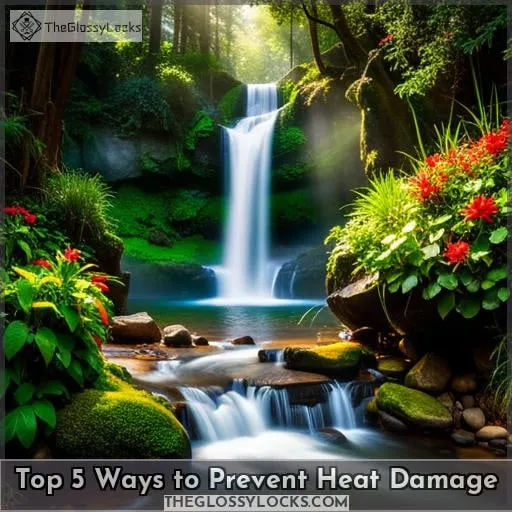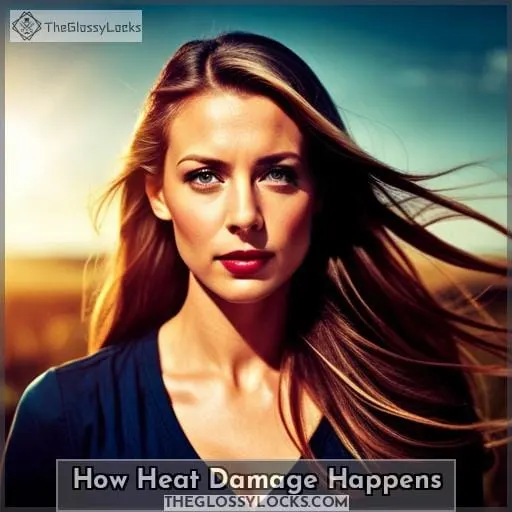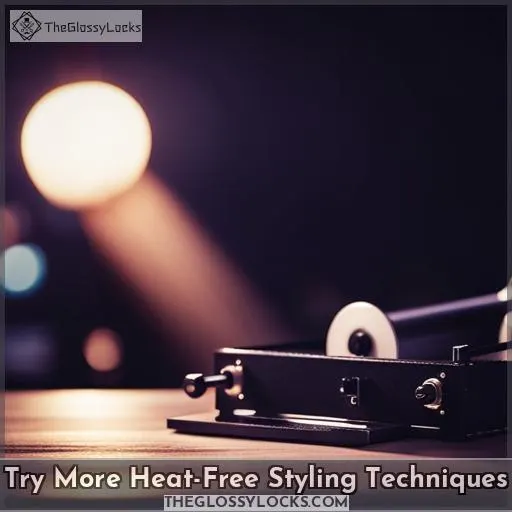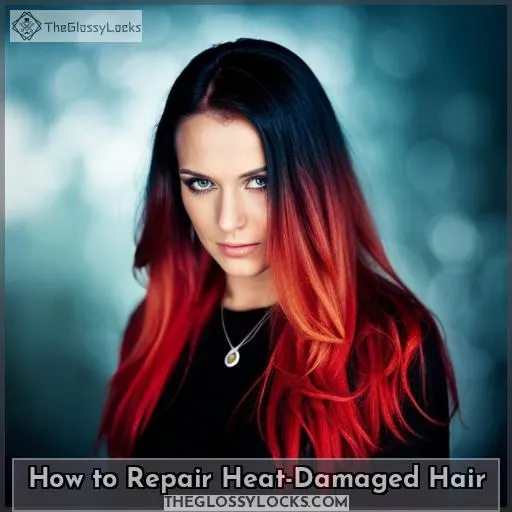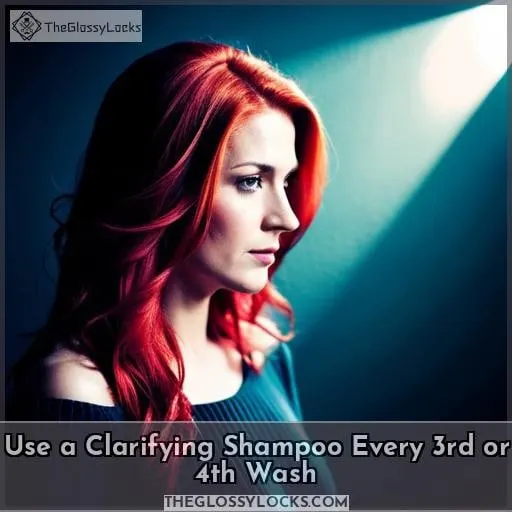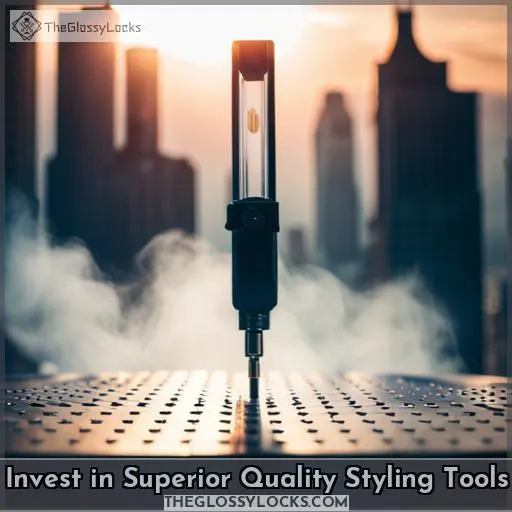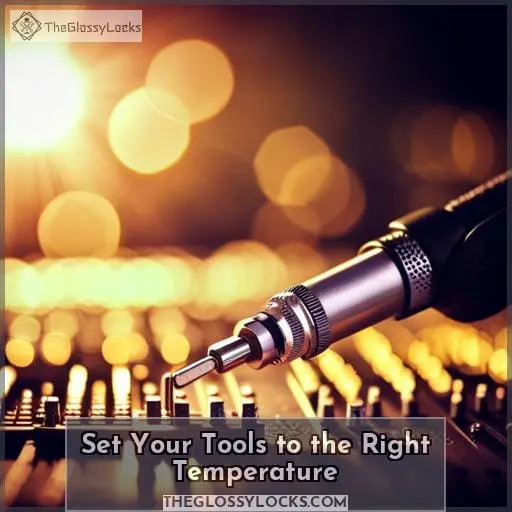This site is supported by our readers. We may earn a commission, at no cost to you, if you purchase through links.
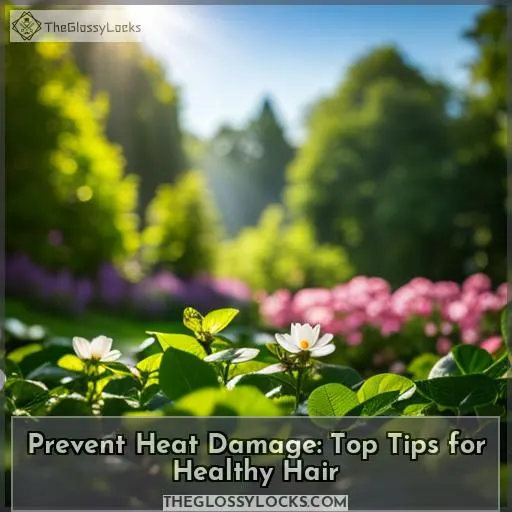 Heat styling can be a great way to get the perfect look, but it’s important to keep in mind how heat damage could affect your hair. No one wants fried strands and split ends! Fortunately, there are plenty of ways you can prevent heat-related destruction from occurring.
Heat styling can be a great way to get the perfect look, but it’s important to keep in mind how heat damage could affect your hair. No one wants fried strands and split ends! Fortunately, there are plenty of ways you can prevent heat-related destruction from occurring.
First, let’s take a closer look at how this kind of damage happens and what we should do about it. Creating protective shields around your hair with leave-in conditioners is a great way to minimize heat damage.
These conditioners act as a barrier between your hair and the heat, reducing the direct impact on your strands.
Investing in superior quality tools is also crucial for preventing heat damage. Cheap or low-quality styling tools can cause uneven heat distribution, leading to hot spots that can burn your hair. Look for tools with adjustable heat settings and ceramic or tourmaline plates, as these materials provide more even heat distribution and minimize damage.
Another important tip is to always use a heat protectant spray before styling your hair. These sprays create a protective layer on your hair, reducing the amount of heat that reaches the strands. Make sure to evenly distribute the spray throughout your hair, focusing on the ends where damage is most likely to occur.
It’s also essential to avoid excessive heat exposure. Limit the use of heat styling tools to a few times a week and try to give your hair a break from heat altogether whenever possible. Embrace natural hairstyles or opt for heatless styling methods to minimize the risk of damage.
Lastly, proper hair care is key to preventing heat damage. Regularly deep condition your hair to keep it hydrated and nourished. Trim your ends regularly to get rid of any split ends and prevent them from traveling up the hair shaft.
And always remember to use a wide-toothed comb or a brush with flexible bristles to minimize breakage when detangling wet hair.
By following these tips, you can prevent heat damage and style your hair confidently without worrying about the long-term effects on your locks.
Table Of Contents
Key Takeaways
- Use protective shields and leave-in conditioners.
- Choose adjustable heat tools with ceramic/tourmaline plates for even distribution.
- Limit heat exposure by opting for natural styles and heatless methods.
- Restore heat-damaged hair with sulfate-free products and deep conditioning.
Top 5 Ways to Prevent Heat Damage
If you want to keep your hair looking healthy and strong, it is important to take steps towards preventing heat damage. This includes creating a protective shield for your hair with a quality heat protectant, using lower temperatures when styling with hot tools, investing in a weekly nourishing hair mask treatment, following the one and done rule when using hot tools on each section of your hair, and scheduling regular trims at the salon.
Create a Protective Shield
By investing in high-quality heat protectant spray, you can create a protective shield around your hair. Heat barrier solutions include leave-in conditioner, hair mask, and serum. Implement thermal shielding techniques and defense strategies to safeguard against heat damage.
Hair care essentials for prevention include customizing formulas with damage-fighting goals and applying protectant before using styling tools. Maintain thermal protection up to 400°F and regularly trim your hair to promote healthy growth, prevent split ends, and boost volume.
Turn Down the Heat
When it comes to styling, dial down the temperatures and give your hair a break! Adjusting intensity is key for safe styling. Opt for low heat settings like 200-300 degrees or switch to alternatives like foam curlers or hook-and-loop rollers.
Cooling measures such as using a protective spray and avoiding dampness also help with temperature control.
Invest in a Weekly Hair Mask
Treat your tresses to a weekly hair mask for an extra boost of nourishment and thermal protection. Repair, rejuvenate, and prevent heat damage with natural ingredients like argan oil or aloe vera gel. DIY hair care provides restorative benefits, while using heat-styling products sparingly helps keep hair healthy long-term.
Follow the “One and Done” Rule
To maintain healthy hair growth and prevent further damage, follow the one and done rule when using hot tools on each hair section. Avoid overexposure with efficient technique for quick styling. Divide ideal sections into heatproof styles to shield from excessive heat.
Go for a Trim
Schedule regular trims with a trusted stylist to prevent split ends and protect hair from damage. Haircuts offer benefits like breakage control, improved health, and better styling results. Regular consultations help maintain the integrity of your locks while calming heat-induced anxiety.
How Heat Damage Happens
Understand why heat damage happens, and you’ll be on your way to a healthier head of hair – as the saying goes, an ounce of prevention is worth a pound of cure. Heat from styling tools like curling irons and hair straighteners can weaken the structure of your strands.
Signs of Damage: Look for dullness in color or texture, dryness, brittleness, split ends, frizziness, and lost curls to identify heat damage.
Hair Structure: Prolonged exposure to high temperatures disrupts bonds within each strand’s protein matrix, which keeps it healthy-looking by retaining moisture loss during thermal protection treatments with hot tools at home or salon visits.
Preventive Measures: To minimize further deterioration, use a low setting when possible (200-300 degrees). Always apply thermal protectant before using a hot tool and deep condition regularly for additional hydration.
Repair Techniques: If you’ve already experienced some degree of damage, try repairing hair with restorative sulfate-free shampoo/conditioner. DIY leave-in conditioners made from water and conditioning spray, along with weekly masks containing nourishing ingredients such as argan oil, can also help.
Heat Impact: Regular trims are also essential since they remove split ends while boosting volume – this will help maintain healthy growth over time, so don’t skip them!
Try More Heat-Free Styling Techniques
Escape the damaging effects of heat styling by experimenting with a variety of heat-free hairstyling techniques. Braided updos, foam rollers, twist out styles, and halo braids are all great options for creating beautiful looks without using hot tools.
Flexi rods can also be used to create curls that last days without requiring any additional heating.
For those with longer hair lengths who love waves or curls, try the Coanda effect technique, which creates soft waves in no time at all! Avoiding heat-damaged hair is possible when you use these no-heat hairstyles and suitable styling tools along with your customized haircare regimen.
Adding deep conditioning treatments just before styling will help keep moisture locked into your strands during heated styling sessions while replenishing lost hydration from external factors like sun exposure or air pollution, as well as internal ones such as hard water usage or chemical processing treatments on dyed colors.
A weekly deep conditioning mask helps strengthen each strand and restore its health so that it doesn’t need to be exposed to high temperatures often. This preserves its natural luster even more than if you were constantly applying heavy amounts of product due to frequent thermal damage caused by hot tools each day.
Finally, regular trims every 3 months (or virtual consultations) keep split ends from spreading further up the length, which would cause irreparable damage over time. This leaves behind duller-looking locks that lack shine despite intense efforts put forth towards repairing them through intensive care routines aimed at restoring their original texture prior to excessive exposure scenarios inflicted upon them through ill-advised choices related directly back to extreme levels of frequent usage of undue amounts of tools & products frequently applied in order to attain desired results quickly, thus leading to irreversible consequences later down the line.
How to Repair Heat-Damaged Hair
To repair heat-damaged hair, start by revamping your haircare routine to include deep conditioning treatments and regular trims. Damage recovery techniques like nourishing treatments can help reverse the effects of keratin damage done by high temperatures.
Repairing regimens should focus on restoring hydration levels and building strength in weakened strands while avoiding further stressors.
Restorative solutions such as low temperature range styling tools, weekly masks, or leave-in conditioners are all great options for preventing future heat damage too! Here are some tips for repairing heat-damaged hair:
- Use a sulfate/paraben-free shampoo and conditioner tailored to your specific needs.
- Apply a heat protectant before using hot styling tools.
- Adjust hot tool temperatures between 200–300°F; lower for finer hair types.
- Incorporate a weekly deep conditioning mask with nourishing ingredients such as argan oil.
- Get regular trims to remove split ends and boost volume.
With these tips in mind, you’ll be able to restore healthy shine back into your locks!
Use a Clarifying Shampoo Every 3rd or 4th Wash
Try using a clarifying shampoo every 3rd or 4th wash to help remove product and excess oils from your hair, giving it the chance to breathe and be restored back to its natural state.
Clarifying shampoos have many benefits that can prevent heat damage. They cleanse deep into the scalp, removing product buildup without stripping away moisture or nourishing ingredients. Additionally, they promote optimal scalp health by helping balance sebum production for an overall healthy hair environment.
When considering how often you should use a clarifying shampoo as part of your haircare routine, keep in mind that sulfate-free products are gentler on textured locks than those with harsher detergents like sodium laurel sulfate (SLS).
Alternately cleansing with both regular and clarifying shampoos will provide an effective way of preventing build up while still maintaining necessary hydration levels for healthier hair growth over time.
Invest in Superior Quality Styling Tools
Investing in superior quality styling tools, like those with ionic conditioning technology, is like putting armor on your hair – it shields from heat damage while allowing you to style with confidence.
. Advanced technology styling tools offer consistent precise results and professional tool brands are designed for durability, both of which contribute to less heat damage.
Heat control innovations allow users to adjust the temperature settings according to their specific needs and provide a safe level of heat exposure that prevents further harm. With high-quality products come greater accuracy when styling. They guarantee clean lines without any snags or tugging at delicate strands, keeping them healthy in the process.
Investing in premium hot items may be pricey, but their worthiness cannot be overstated.
Set Your Tools to the Right Temperature
When it comes to avoiding heat damage, it’s essential to set your tools to the right temperature. Optimal temperatures vary depending on hair type and tool selection. Hair experts recommend adjusting temperatures between 200-300 degrees for most hair types.
Finer strands require lower heat settings, while thicker textures can handle higher intensity with proper protection from a quality product like Function of Beauty’s Heat protectant spray.
Despite this range, it’s important to avoid high heats above 410°F to prevent long-term damage when styling regularly. This is especially true when using professional styling tools, which are designed for more intense use than standard hot irons or curling wands.
Remember these simple tips to keep your hair healthy and repair any damaged strands that may have occurred due to excessive heat exposure over time!
Conclusion
With heat styling, it’s all about moderation. Following a few simple steps, such as investing in heat protectant, using the lowest temperature setting, and getting regular trims, can help prevent heat damage and keep hair looking healthy.
For those experiencing heat-damaged hair, there are plenty of ways to repair it, including gentle sulfate-free shampoos, deep conditioning masks, DIY leave-in conditioners, and more. The key is to keep an eye out for signs of damage and to take the necessary steps to prevent or repair it.
With a little TLC, heat-damaged hair can be revived and restored to its natural beauty.

